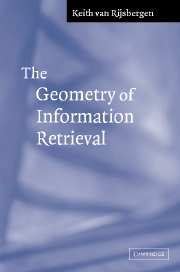Book contents
- Frontmatter
- Contents
- Preface
- Prologue
- 1 Introduction
- 2 On sets and kinds for IR
- 3 Vector and Hilbert spaces
- 4 Linear transformations, operators and matrices
- 5 Conditional logic in IR
- 6 The geometry of IR
- Appendix I Linear algebra
- Appendix II Quantum mechanics
- Appendix III Probability
- Bibliography
- Author index
- Index
6 - The geometry of IR
Published online by Cambridge University Press: 14 January 2010
- Frontmatter
- Contents
- Preface
- Prologue
- 1 Introduction
- 2 On sets and kinds for IR
- 3 Vector and Hilbert spaces
- 4 Linear transformations, operators and matrices
- 5 Conditional logic in IR
- 6 The geometry of IR
- Appendix I Linear algebra
- Appendix II Quantum mechanics
- Appendix III Probability
- Bibliography
- Author index
- Index
Summary
‘Let no man enter here who is ignorant of geometry’
PlatoIn the previous chapters we have introduced set-theoretic, logical and algebraic notions, all of which can be used profitably in IR. We now wish to broaden the discussion somewhat and attempt to introduce a language and a notation for handling these disparate notions within a single space, viz. Hilbert space (Simmons, 1963), thereby constructing a probability measure on that space via its geometry. At first glance this appears to be a difficult task, but if we consider that much IR research has been modelled in finite vector spaces (Salton, 1968) with an inner product, many of our intuitions for that can be transferred to the discussion based on Hilbert spaces. One major reason for adopting the more abstract point of view is that we wish to present a ‘language’ for describing and computing objects, whether text, image or speech, in a general way before considering any particular implementation.
The language introduced uses a small set of operators and functions, and the notation will be the Dirac notation (Dirac, 1958). Although at first sight the Dirac notation strikes one as confusing and indeed awkward for learning about linear algebra, its use in calculating or computing simple relationships in Hilbert space is unparalleled. Its great virtues are that any calculation is simple, the meaning is transparent, and many of the ‘housekeeping’ rules are automatically taken care of. We will demonstrate these virtues as we progress.
- Type
- Chapter
- Information
- The Geometry of Information Retrieval , pp. 73 - 100Publisher: Cambridge University PressPrint publication year: 2004
- 2
- Cited by

